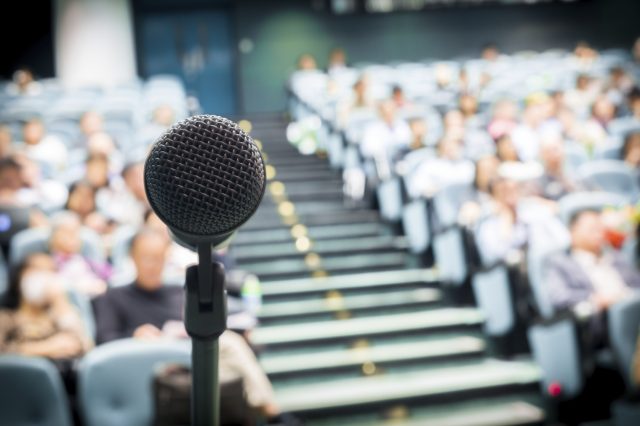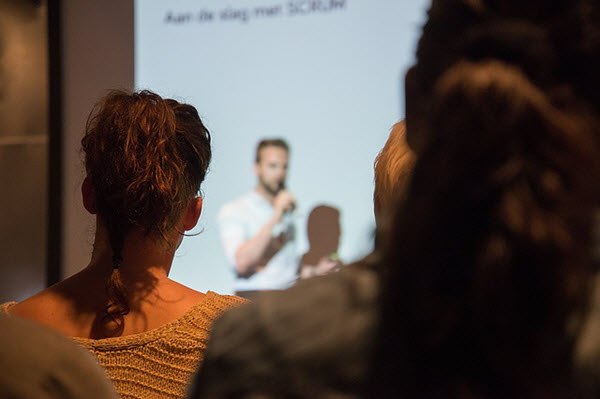7 Killer Ways to Connect with your Audience During a Speech
By David
December 14, 2018 • Fact checked by Dumb Little Man

It’s probably your worst nightmare. You’re giving a speech, and you start to stumble. You mix up a few of your words, lose your train of thought, and then you can’t seem to get back on track.
Sweat is forming on your brow and you’re starting to hyperventilate. You’re asking yourself: is it hot in here, or is it just me? Is there a rock nearby I can climb under?
If anything like this has happened to you, I’ll bet it was painful.
Giving a speech is no easy task. Not only do you have to have something worthwhile to say, but you also have to say it in a way that connects with your audience.
If you have ever delivered a speech where you failed to connect with your audience members, I have good news. You don’t have to be the world’s most captivating speaker to deliver a dynamic, entertaining speech.
In a previous DLM post, 7 Little-Known Ways to Conquer Your Fear of Public Speaking, I discussed how to calm your own nerves and be comfortable delivering a speech before an audience.
In this post, I’m going to discuss the next step in delivering a good speech — how to actually make a connection with your audience members.
Why You Need to Connect With Your Audience Members
At its core, a speech is just a conversation. Like any conversation, your job is to communicate certain information to the people listening, whether it’s one person or one thousand.

But the problem is that we are all subject to such an onslaught of information today that it’s very difficult to break through the noise.
Your job as a speaker is to make a connection with your audience so that they will be more open and receptive to actually accepting and retaining your message.
Let me put a more fine point on it:
If you don’t grab your audience’s attention, you will lose their interest in a heartbeat and your speech will just be a giant waste of time.
In that spirit, here are 7 killer ways to connect with your audience during a speech:
Talk About What Your Audience Wants You to Talk About
This may seem kind of basic, but how do you know you’re even talking about the things your audience wants you to talk about?
Most people who give a speech pick the topic and write the speech independently and without any input from the potential audience. Rather than doing that, flip that process around. Find out what your audience wants to hear, then talk about that.
Do some basic audience research by contacting people who will be in the audience and interviewing them about a few of the questions they want answered. It’s much better to find these things out in advance rather than afterwards.
Refer to Audience Members by Name

Have you ever noticed how politicians tend to start speeches by mentioning a few of the dignitaries in the audience by name? There’s a reason why they do that.
People love to receive recognition, especially if it’s acknowledgment in front of peers or colleagues.
So, the next time you speak, don’t be afraid to name-drop- that is, to drop names of people who are in the audience while you’re speaking.
Better yet, use stories or examples involving people who you know will be in your audience to illustrate your points. At a minimum, you know at least one person will be paying attention.
Have a Sense of Humor
You ever wonder why so many speeches start with the speaker making a joke? When a speaker starts with a joke, it sends a signal to the audience that they can relax.
Unfortunately, audiences have been conditioned by bad speakers to expect to be bored. It’s all too easy for audience members’ minds to wander.

Sprinkling jokes throughout a speech guarantees your audience will pay a little more attention. At least, they will be listening closely for the next joke to come along. So, including a little humor in your speech is actually a great way to get your points across.
Be a Revolutionary: Do The Opposite of Everyone Else
I can still remember one of the most powerful speeches I ever heard in person as if it were yesterday.
The year was 2003. I was at the California State Democratic Party’s annual convention, where a parade of potential Presidential candidates were addressing the crowd. Then-Senators John Kerry and Hillary Clinton and a host of others delivered slightly different versions of the same speech, giving the audience of party stalwarts what it wanted to hear on various political issues.
Then a little-known Governor named Howard Dean came up to the podium.
Dean immediately ripped into the other speakers, using a refrain of “What I want to know … is why” the other speakers were not talking about issues like health care and the War in Iraq.
The audience erupted, devouring the red meat and Dean’s willingness to take a stand.
So, what’s the lesson for you?
If everyone else is giving PowerPoint presentations, don’t do it. If everyone else is entering from stage left, enter from the back of the room. If everyone else is being polite, be willing to ruffle a few feathers.
Doing the unexpected will make it more likely your audience will sit up and pay attention.
Wrap Your Points in Relevant Stories
The best speakers understand the power of stories. Nearly every audience would much rather hear stories than receive the information any other way.
But it’s not enough to just tell funny or amusing stories. You need to tell stories which illustrate your points.
A classic example of this is the brilliant Stanford commencement address Steve Jobs gave in 2005. “Today, I want to tell you three stories from my life,” Jobs said at the outset of the speech. “That’s it. No big deal. Just three stories.”
Jobs then proceeded to use the three stories as the basis for his larger message, including points about “connecting the dots” in your life and how major life setbacks can be a blessing in disguise.
Jobs was smart enough to know that you’re more likely to connect with your audience if you use stories as the framework for larger messages.
Open Your Heart

If you really want to make a connection with your audience, get personal.
Tell a revealing story. Share a side of you few ever see. Allow it all to hang out, warts and all.
People will respect your honesty and candor, especially if you show you are not perfect.
Sure, it won’t be easy to be truly open and vulnerable, but few things in life are easy. And the payoff will be worth it.
Be Like Oprah: Give Your Audience Gifts
Finally, if you really want to show your appreciation to your audience members, give them a gift.
I’m not saying you have to give everyone in the audience a car, like Oprah.
But what you can do is really over-deliver by giving your audience a resource, guide or information piece which they will truly value.
It could be a handout that summarizes your most valuable advice and tips or a handy chart or an infographic or even a book.
Make it so good that you can imagine people placing it front and center on their desks or sleeping with it under their pillow. Yes, it should be that good.
Do that and your audience will never forget you or your message.
What tips do you have for connecting with audience members during a speech? Put them in the comments below.
Photo Credit: thinkmedialabs







